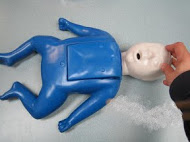The choking of infants under age one is not an uncommon incident. Choking occurs when a person cannot breathe due to an object blocking the airway, either the throat or the windpipe. The objects can be anything from food to toys. Choking is either classified as partial or complete of the airway. Partial blockage of the airway occurs when the airway is not blocked completely but causes the victim to not breathe sufficiently. It may easily lead to a medical emergency. On the other hand, complete blockage of airway occurs when an object completely blocks the airway leading to the inability to breathe. It is considered a medical emergency. There is danger of permanent brain damage when the brain does not receive sufficient amount of oxygen in as little as four minutes. Thus, the importance of knowing first aid for choking of infants under age one and any age is an essential survival skill.
Causes of Choking of Infants under Age One
Infants under age one are capable of minimal movement and are thus able to grab the small objects in their immediate environment. There are many possible causes of choking in infants under age one, thus it is important to be on guard when handling children. The most common objects an infant can choke on include:
- Food, such as peanuts and junk food
- Coin
- Button
- Balloon
- Parts of a toy
- Watch battery
Signs and Symptoms of Choking of Infants under Age One
It is important watch out for the following signs and symptoms of choking of infants under age one, especially since they cannot yet say what is happening to them:
- Bluish color of the skin (cyanosis)
- Difficulty breathing – ribs and chest pulled inward
- Inability to make much sound or cry
- Weak coughs
- During inhalation, soft or high-pitched sounds are produced
- If blockage is not cleared, loss of consciousness
First Aid Management for Choking of Infants under Age One
The following steps are generally recommended in cases of choking of infants under age one: When an infant is coughing hard or has a strong cry, first aid is different as strong cough and cries and clear the airway. If the infant is not coughing hard or does not have a strong cry, the following steps are recommended:
- Lay the infant down, along the forearm, while using the thigh or lap for support. Using the hand, hold the infant’s chest and using the fingers, hold the jaw. Point the infant’s head downward, with the head lower than the body.
- Give up to five quick, forceful blows in between the shoulder blades of the infant. Make use of the palm of the free hand.
If the previous steps do not work, follow the recommended steps:
- Turn the infant face-up while using the lap or thigh for support. Make sure the head is supported.
- Just below the nipples, place two fingers on the middle of the breastbone.
- Give up to five quick thrusts down, while compressing the chest to one-third to one-half of the chest depth.
- Continue giving five back blows followed by five chest thrusts until the object is removed or until the infant becomes unconscious.
- If the infants becomes unresponsive, stops breathing or turns blue, perform infant CPR. Call for emergency medical help after one minute of doing CPR.

To learn how to properly administer first aid in choking of infant under age one, enroll in First Aid Courses specific for babies and infants with CPR Training.
Online Sources:
